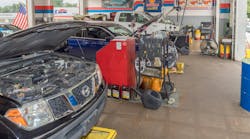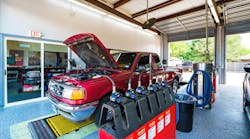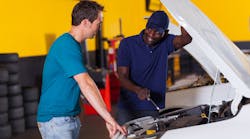One of the hallmarks of quick lube is fast and reliable service. Despite striving for the most efficient service possible, lines are inevitable.
Customers will have to wait sometimes to get their vehicles serviced, but that doesn’t mean being stuck in line has to be a negative experience.
Matt Webb, president of Premier Oil Change, operates seven locations in Northern California and Southern Oregon, some of which average nearly 70 cars per day. He says there are several very basic adjustments shops can make to their process to make sure customers have the least painful wait possible.
Step 1: Make a great first impression.
Most shops deal with what Webb calls “street resistance”—the all-too-common phenomenon that happens when people drive by, see a line extending out of the bays and drive away.
Some street resistance is inevitable. People are impatient, and your techs can only work so fast. However, your shop can minimize street resistance by being efficient and building a reputation that your service is worth waiting for.
“We don't know how many cars we're actually losing or not doing as a result of just the bay time. That’s street resistance,” Webb says. “Because of that, when people do pull on the lot, we need to give them every reason in the world to stay.”
Webb says he emphasizes the first contact and initial greeting with a customer at all seven of his locations.
“If a staff member walks out with a sense of urgency and welcomes them to the shop, it's an entirely different experience for the customer than if the staff member walks out slowly and doesn't look engaged,” he says. “That's our first line of defense for keeping the guests on the lot, that first initial greeting.”
Step 2: Focus on the little things.
People like free things. Even something small, such as a complimentary water or coffee, will help customers feel like their time is valued.
“That makes people feel good. It makes them feel comfortable,” he says. “Before you offer any services to the vehicle, just making sure that the customer knows that, ‘hey, we see you, we know it's going to be a little bit of a wait, sorry, but we really appreciate you being here and want to do everything to make sure you're comfortable’ goes a long way.”
Step 3: Start before their service does.
Free beverages and a friendly greeting are important, but they only get your shop so far. Customers in line will be watching how fast your team is moving inside the bays, and Webb says no amount of coffee will keep them there if they feel as though things aren’t moving as efficiently as they could be.
“Obviously, you want to keep cars moving through the bays as quickly as possible,” he says. “If everyone's moving with a sense of urgency, if they see that these guys are moving to doing everything quickly, the perception is that the service is going to be faster, even if it takes the same amount of time.”
One of the easiest ways to boost efficiency and actually reduce service times, however, is to start service before a car pulls into a bay. Webb says checking a guest in, getting their personal information and even determining what services their car will need through a wireless device will help reduce the amount of work that needs to be done once a car rolls in.
“The guests should be checked in before they roll into the bay,” he says. “That’s going to save a significant amount of time if you can determine what you’re going to do to a guest’s car while they’re waiting. “
Step 4: Manage workflow both in and out of the bays.
Maintaining an orderly workflow is another simple-yet-highly effective step to improve efficiency.
Webb says the workflow management happens in two places: In the lines and in each bay. In multi-bay shops, it’s easy for one line to start moving faster than the others and for people to have uneven wait times.
“In stores that have a higher volume, a critical issue is managing the lines correctly,” Webb says. “The manager should always be monitoring that line to put the cars on the right base so no one gets passed up or skipped.”
Once a car is in the bay, making sure all of your equipment and tools are in optimal spots is crucial for maximized efficiency.
“I go to oil change centers and I see guys walking from bay one to bay three to look for a wrench to take off an air filter, and they just wasted a few minutes trying to find the right tool,” Webb says. “If they do that 10 times a day, that's 20 minutes of productivity. Even when there is no line, your team still needs to maintain that same sense of urgency.”
Optimizing your lines and making sure your customers have as good of a waiting experience as they can doesn’t require a significant overhaul to your operation; several small changes aimed at improving efficiency in several key areas can go a long way in boosting the customer experience.
“It doesn’t take a whole lot, but just doing some really basic things to make sure that your customers feel like they’re appreciated and making some basic enhancements to efficiency at each bay can help really bump up that customer service experience, even if wait times are a bit long.”





